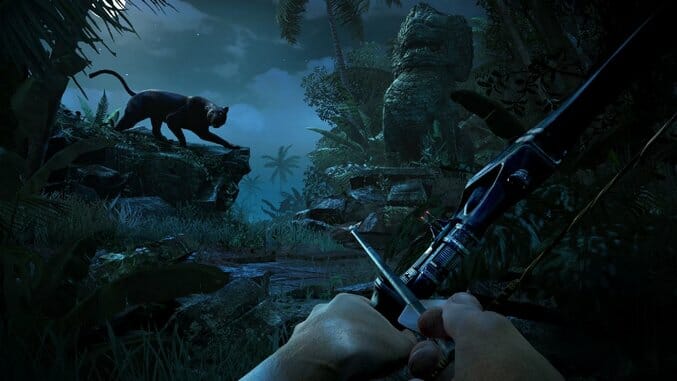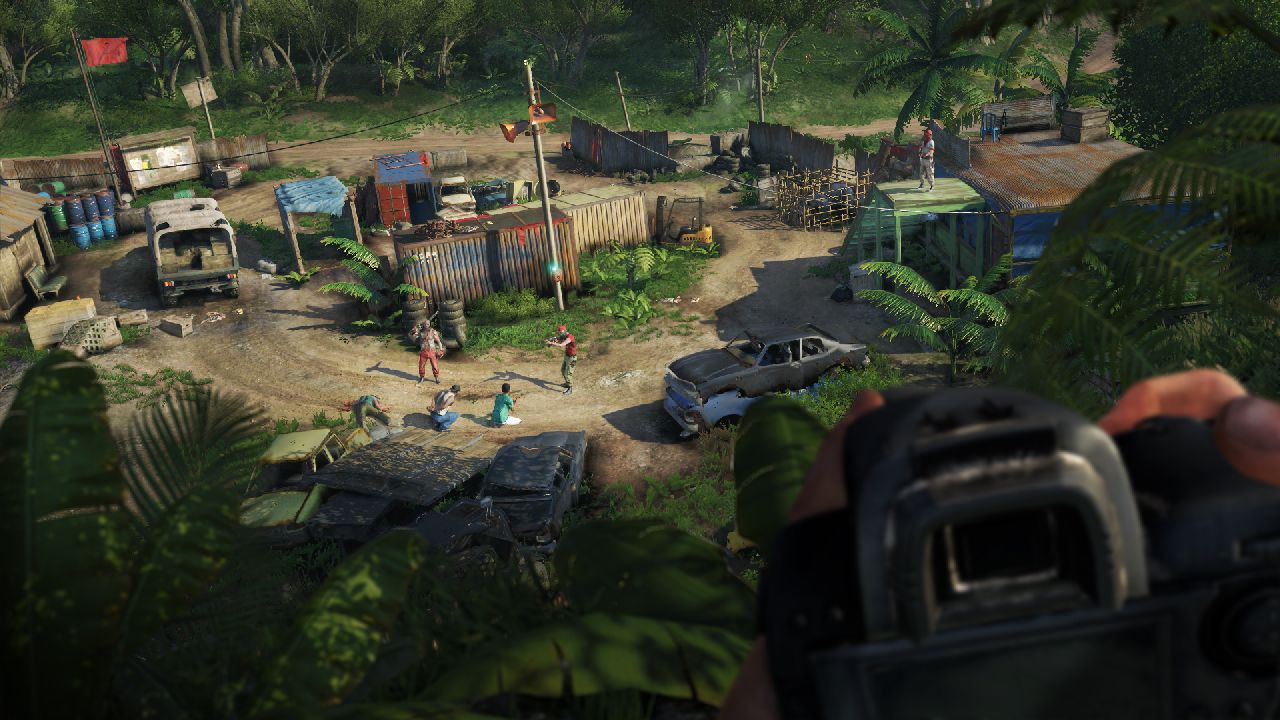
Shut out the story. Ignore the yellow exclamation points that litter the map one at a time. Focus on conquering enemy compounds, slinking over hills and through tall grass, scoping out the fort below with your camera and plotting the most painless route to victory. Target the radio towers, which are dispersed throughout the archipelago and which act like the vantage points in an Assassin’s Creed game: Climb to the top, hit a button, and a wide new swath of land will be added to your map. Hop on a jet ski or hang glide out into the ocean, where you can stab a shark and make yourself a fancy new wallet. Collect herbs and animal skins to craft medicine and new accessories. Stare longingly at the three distinct skill trees that will take you forever to climb since you’re avoiding the story missions and their wealth of experience points. Or just aimlessly explore the game’s expansive world, engaging in scenarios with enemies and wildlife as they pop up.
Do these things, and Far Cry 3 is excellent. It’s a thrilling first-person shooter that alternates action with long passages of exploration. It requires thought, strategy and patience. It isn’t just a full-speed-ahead shooting gallery. It’s not the revelation that Far Cry 2 was, in part because it plays very much like Far Cry 2, but the lush new jungle setting and the four years between the two games mitigate the sense of repetition.
As invigorating as the game’s play can be, it wears thin without a narrative framework. You can only creep up on and kill a bear or an entire camp of pirates so many times before you start looking for additional motivation. And when you turn to Far Cry 3’s story to boost your flagging interest, you’ll quickly realize a crucial distinction between this game and its predecessor: Far Cry 3’s story is absolutely atrocious. It’s also bigger, flashier and more central to the game, and thus not something that can just be dismissed or ignored in a review.
In Far Cry 3 you’re basically a Real World cast member partying your way through Southeast Asia. You and your friends club, drink, skydive, and generally live without fear or limits, all paid for by a friend’s dad’s black card. You make smartphone videos set to M.I.A. songs. You’re rich, beautiful hedonists blowing cash in the Pacific Rim. You pick the wrong island to parachute onto, though, and your friends immediately wind up imprisoned by a gang of pirates and slavers.
An opening montage and occasional flashbacks show us what the lead character and his friends were up to before being kidnapped. It’s all cringe-inducing, with every stereotype of the privileged, oblivious American tourist distilled into a half-dozen ciphers. You’re obviously supposed to dislike these people and yet the game still asks you to spend hours trying to rescue them one by one. It’s hard to invest in these characters, especially when the lead follows a predictable Heart of Darkness path.

It would have been possible to look past this, though. Games regularly ask us to care about characters without giving us any reason to. What turns Far Cry 3 into a total mess is how the game handles the native population. Every native character is a ruthless criminal, an easy-going villager, or a “noble savage” who trains our white American lead to become the perfect warrior while also begging him to do all of the hard work. Far Cry 3 is about an invincible, tatted up dude bro on a jet ski killing two entire islands full of lazy stereotypes.
Between the threats of white slavery and sexual violence and the overall racial disquietude, Far Cry 3 feels like an old exploitation film. The jungle is unknowable and untamable and will destroy you in the end. It will turn you into an animal and then sacrifice you to its warrior sex god. Fear the unknown. The other is evil. Yes, the final villain is European, and the damage done by colonialism is clearly subtext, but that doesn’t make Far Cry 3’s deployment of unfortunate tropes any less ugly or uncomfortable.
Far Cry 2 was similarly nihilistic, but it avoided the racial unease and didn’t take such a generic run at the Heart of Darkness theme. Yes, most of the bad guys were African, but you could pick from a culturally diverse roster of lead characters, none of whom were a normal guy trapped in a bad situation. You weren’t some frat guy from California. Your friends weren’t scared innocents. You were a hardened mercenary looking to kill and make money, and you associated with other hardened mercenaries. The game never tried to make you empathize with or care for your character. There was no past between you or your friends in Far Cry 2, no deep personal bond, but those relationships had power because your friends could save you from death. One of the most memorable and harrowing moments in any recent game is when your Far Cry 2 friend is injured while saving you and you have to either let him or her die slowly or put a bullet through the brain to end the suffering. Nothing in Far Cry 3 approaches that level of emotional investment, and it deals with delicate real world issues with less nuance.
Everything that Far Cry 3’s single-player campaign does well, from the large open world to the emergent gameplay, was done just as well in Far Cry 2. Far Cry 3 recreates why people loved to play Far Cry 2, and you’ll no doubt read many permadeath diaries and tense dispatches from breathless correspondents who parachuted off a waterfall before killing fifteen guys with a bow and punching a komodo dragon. Focus on that part of the game and you’ll love it. Stray back onto the story’s path and you’ll quickly remember why you were avoiding those exclamation points.
Far Cry 3 also features co-op and other multiplayer modes. This review solely considers the single-player campaign.
Far Cry 3 was developed by Ubisoft Montreal and published by Ubisoft. Our review is based on the PlayStation 3 version. It is also available for the Xbox 360 and PC.
Garrett Martin edits Paste’s games section and reviews games for the Boston Herald and elsewhere. You can follow him on Twitter, if you’d like.